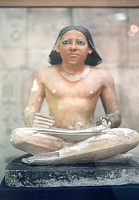One of the most interesting things about books and scrolls in Jesus’ world is where we find them. One might expect to find them in the ruins of houses, or under the Temple Mount. Where we most often find them is in hiding places, chiefly in caves, and more caves. and more caves. Books were highly prized in the world of Jesus, they were the things you took with you to wherever you sought refuge from invaders, or oppressors of various sorts. A standard roll of papyrus in mid-first century A.D. Egypt cost four drachmae, which is to say it cost about 4-8 days pay of an ordinary workman. But let us take for example, the famous Isaiah scroll found at Qumran. A roll thirty feet long took no less than 30 or so hours to fill up. That is— at least three full days work for a scribe like the one pictured above (my shot from the museum of Egyptology in Cairo). A copy of Isaiah then could cost at least 10 denarii, and that is a low guess. And then you would have exactly ONE book of the OT in your hands. Imagine about 40 more rolls that long and you can imagine an OT on scrolls.
One of the major differences between scribes working in Jesus’ world and those in the Greco-Roman world is that they were not slaves. They were instead free artisans practicing their trade, and they were without question in huge demand, mainly for the composition of practical documents— wills, property deeds etc. Another difference would be that Jewish scribes copying scrolls did not do so in scriptorium fashion writing while listening to someone read the document. No, they composed by comparing. They acted alone so far as we can tell. The largest single group of such scribes would have been connected either with the Temple, or the various palaces of rulers. But in every town there would have been someone who could draft documents on demand, and most people would not want to go to despised tax collectors to do the job.
The ordinary person in Jesus’ world was assumed to be able to read: 1) decrees, 2) edicts, 3) signs, 4) inscriptions, and 5) placards like that hung round Jesus’ neck on the way to execution. A rudimentary kind of literacy was assumed for a wide audience by the governing officials. Millard concludes “only the most isolated hamlets in Herodian Palestine may have lacked anyone who could read” (p. 168).
As we said in the previous post, writing was a specialty skill, and literacy ancient style should not be based on estimates of who could write. The real question is— who could read? It is interesting that by Jesus’ day the term scribe had taken on a special almost technical sense— it meant someone who could write and interpret Scripture, hence the ancient equivalent of an exegete or theologian. This is why Pharisees and Sadducees both had scribes, not just to do the writing but to interpret it, as the Pharisees were just lay people, and the Sadducees, while of priestly descent were by no means ‘seminary’ educated.
Millard points out that the market for synagogue rolls would have been large, and continuous, for books used a lot like the Pentateuch, the Psalms, Isaiah which seems to have been exceedingly popular. Papyrus tore and wore out. It decayed as well in damp environments. Right in Jesus’ backyard in Sepphoris we now have archaeological evidence of an administrative records office mentioned both by Josephus and the Mishnah (Life 38;Qid. 4.5). There were secular as well as sacred places where documents were kept, and in addition there were more well to do folk who owned their own scrolls. Scribes would be called upon as well to draft letters written in a fair hand. We have reference to such private letters in 1 Maccabees and note the reference to Rabbi Gamaliel II dictating a letter to a scribe in B.T. San. 11b. The notion that we could dismiss the idea that NT authors might use scribes to compose their documents is simply a reflection of historical ignorance. They could and they did, as the voice of Tertius in Rom. 16.22 makes evidence.
One of the more fascinating cave finds is the finds from the so-called Bar Kokhba caves. Bar Kokhba, for those who don’t know Jewish history, led the second great Jewish revolt in the early second century A.D. It would be hard to imagine a person more anti-Roman, and for that matter anti-Greek culture to some extent. Yet in that cave we find documents composed in both Aramaic and in Greek, including legal documents in both languages, sometimes both languages in one document. It was a multi-lingual environment and it had been since the time of Alexander.
There is so much more of this kind of evidence we could discuss and display, but this is enough to make clear to us that we must never imagine Jesus, or his disciples as backwater, backward, illiterate peasants. Southern Galilee in general was no backward. Jewish education was exemplary in that period, and there were plenty of scribes and scrolls for the writing down of things.













